Fluid level checks
1. Fluids are an essential part of the lubrication, cooling, brake, clutch and other systems. Because these fluids gradually become depleted and/or contaminated during normal operation of the vehicle, they must be periodically replenished. See Recommended lubricants and fluids and Capacities in this Chapter’s Specifications before adding fluid to any of the following components. Note: The vehicle must be on level ground before fluid levels can be checked.
Engine oil
2. The engine oil level is checked with a dipstick located at the front side of the engine (see illustration).
4.2 The engine oil dipstick is located on the front (radiator) side of the engine
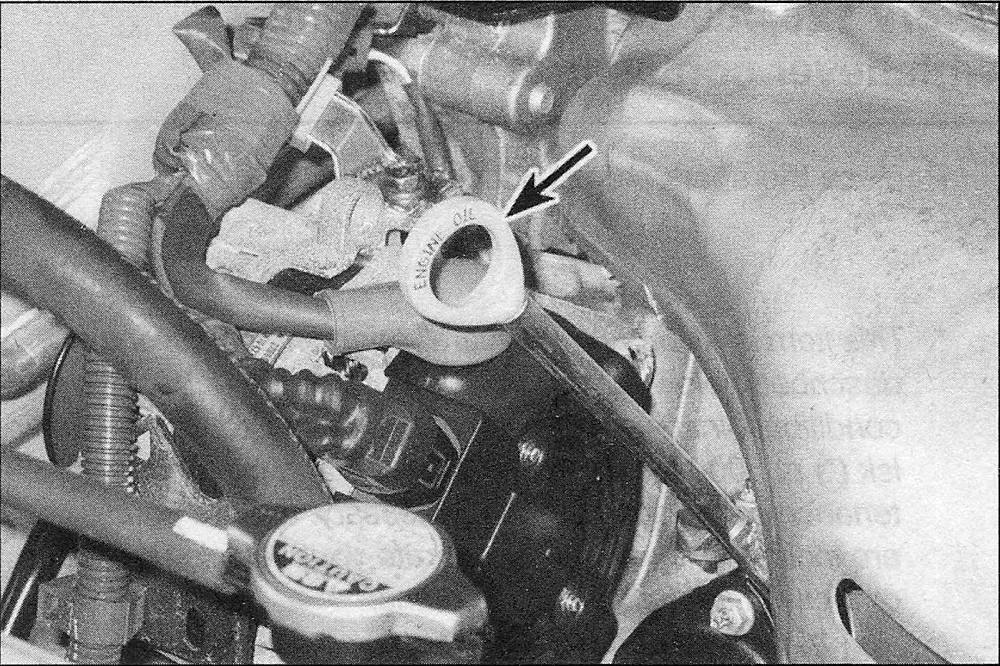
3. The oil level should be checked before the vehicle has been driven, or about 5 minutes after the engine has been shut off. If the oil is checked immediately after driving the vehicle, some of the oil will remain in the upper engine components, producing an inaccurate reading on the dipstick.
4. Pull the dipstick from the tube and wipe all the oil from the end with a clean rag or paper towel. Insert the clean dipstick all the way back into its metal tube and pull it out again. Observe the oil at the end of the dipstick. At its highest point, the level should be between the L and F marks (see illustra tion).
4.4 The oil level should be at or near the F mark on the dipstick — if it isn’t, add enough oil to bring the level to or near the F mark (it takes about one quart to raise the level from the L to F mark)
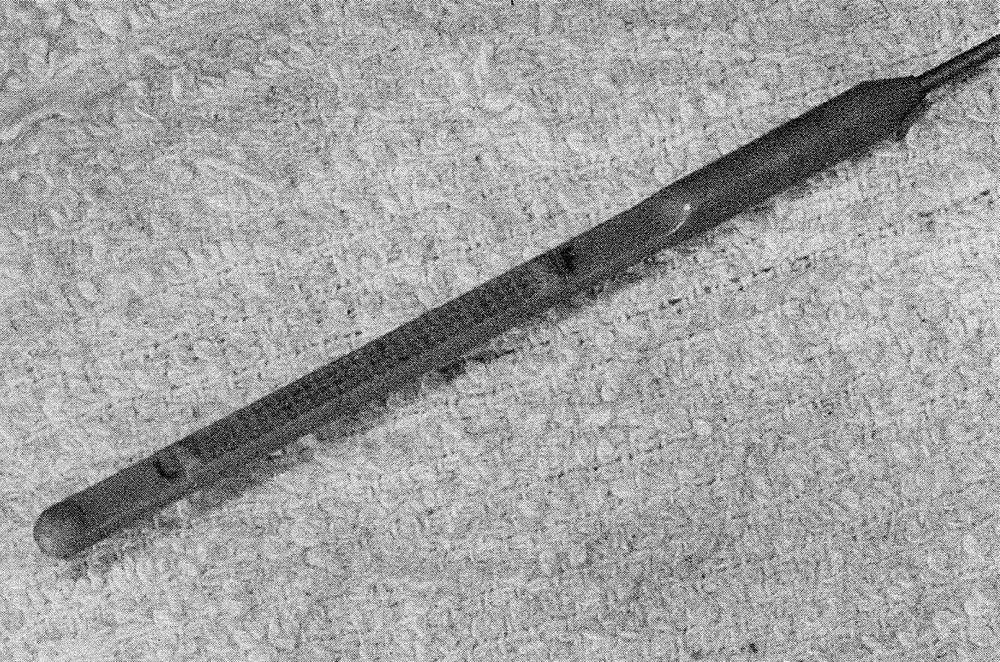
5. It takes about one quart of oil to raise the level from the L mark to the F mark on the dipstick. Do not allow the level to drop below the L mark or oil starvation may cause engine damage. Conversely, overfilling the engine (adding oil above the F mark) may cause oil-fouled spark plugs, oil leaks or oil seal failures.
6. Remove the threaded cap from the valve cover to add oil (see illustration). Use a funnel to prevent spills. After adding the oil, install the filler cap hand tight. Start the engine and look carefully for any small leaks around the oil filter or drain plug. Stop the engine and check the oil level again after it has had sufficient time to drain from the upper block and cylinder head galleys.
4.6 The threaded oil filler cap is located on the valve cover — to prevent dirt from contaminating the engine, always make sure the area around this opening is clean before removing the cap (engine cover removed)
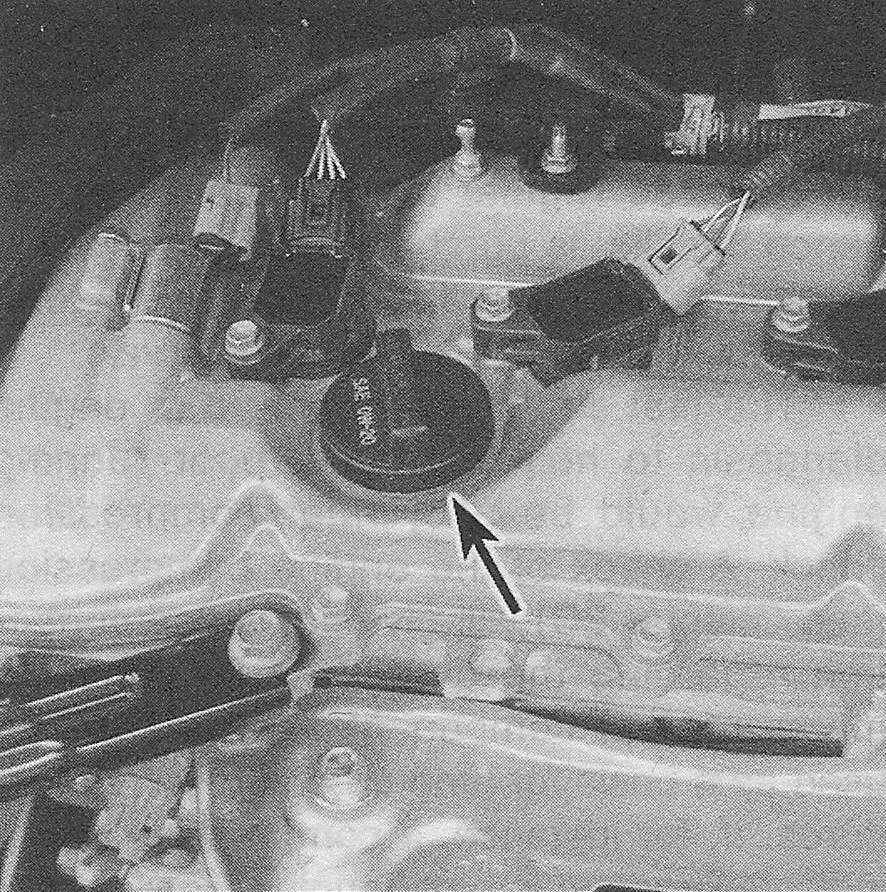
7. Checking the oil level is an important preventive maintenance step. A continually dropping oil level indicates oil leakage through damaged seals, from loose connections, or past worn rings or valve guides. If the oil looks milky in color or has water droplets in it, a cylinder head gasket may be blown. The engine should be checked immediately. The condition of the oil should also be checked. Each time you check the oil level, slide your thumb and index finger up the dipstick before wiping off the oil. If you see small dirt or metal particles clinging to the dipstick, the oil should be changed (see Engine oil and oil filter change).
Engine coolant
Warning: Do not allow antifreeze to come in contact with your skin or painted surfaces of the vehicle. Flush contaminated areas immediately with plenty of water. Don’t store new coolant or leave old coolant lying around where it’s accessible to children or pets -they’re attracted by its sweet smell. Ingestion of even a small amount of coolant can be fatal! Wipe up garage floor and drip pan spills immediately. Keep antifreeze containers covered and repair cooling system leaks as soon as they’re noticed.
8. All models covered by this manual are equipped with a coolant recovery system. The coolant reservoir is located in the front corner of the engine compartment and is connected by a hose to the base of the coolant filler cap (see illustration). If the coolant heats up past a certain point during engine operation, cool ant can escape through the pressurized filler cap and connecting hose into the reservoir. As the engine cools, the coolant is automatically drawn back into the cooling system to maintain the correct level.
4.8 Make sure the coolant level is between the Full (A) and Low (B) lines — if it’s below the Low line, add a sufficient quantity of the specified mixture of antifreeze and water
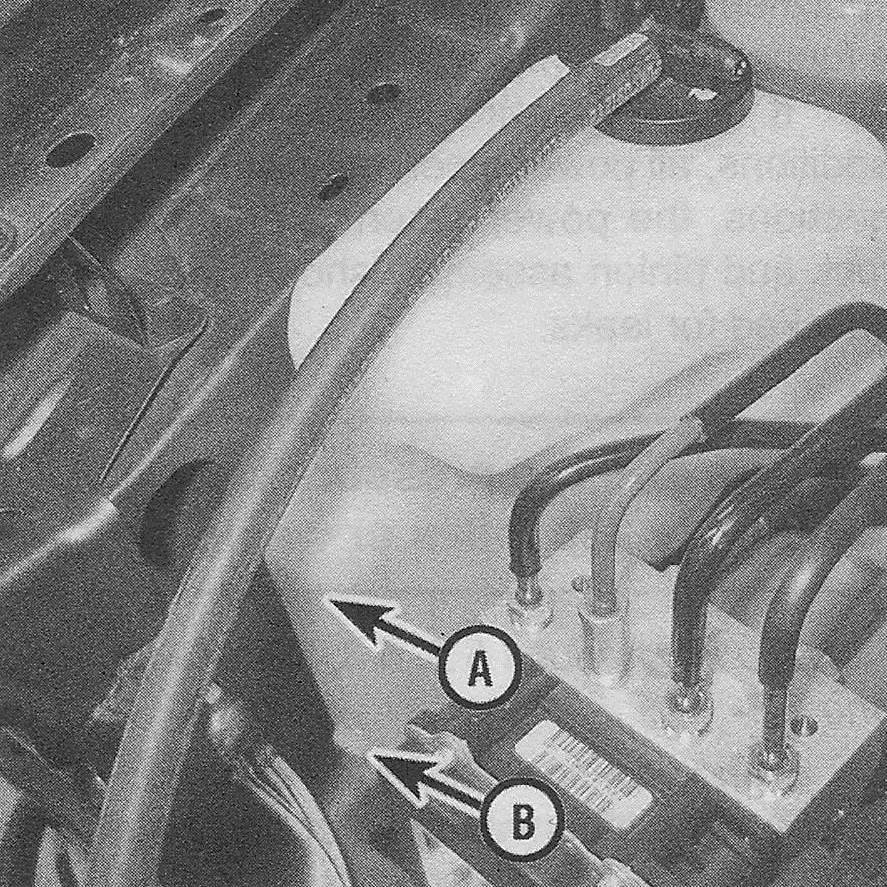
9. The coolant level should be checked regularly. It must be between the Full and Low lines on the tank. The level will vary with the temperature of the engine. When the engine is cold, the coolant level should be at or slightly above the Low mark on the tank. Once the engine has warmed up, the level should be at or near the Full mark. If it isn’t, allow the fluid in the tank to cool, then remove the cap from the reservoir and add coolant to bring the level up to the Full line. Use only ethylene/glycol type coolant and water in the mixture ratio recommended by your owner’s manual. Do not use supplemental inhibitors or additives. If only a small amount of coolant is required to bring the system up to the proper level, water can be used. However, repeated additions of water will dilute the recommended antifreeze and water solution. In order to maintain the proper ratio of antifreeze and water, it is advisable to top up the coolant level with the correct mixture. Refer to your owner’s manual for the recommended ratio.
10. If the coolant level drops within a short time after replenishment, there may be a leak in the system. Inspect the radiator, hoses, engine coolant filler cap, drain plugs, air bleeder plugs and water pump. If no leak is evident, have the radiator cap pressure tested. Warning: Never remove the radiator pressure cap when the engine is running or has just been shut down, because the cooling system is hot. Escaping steam and scalding liquid could cause serious injury.
11. If it is necessary to open the radiator cap, wait until the system has cooled completely, then wrap a thick cloth around the cap and turn it to the first stop. If any steam escapes, wait until the system has cooled further, then remove the cap.
12. When checking the coolant level, always note its condition. It should be relatively clear. If it is brown or rust colored, the system should be drained, flushed and refilled. Even if the coolant appears to be normal, the corrosion inhibitors wear out with use, so it must be replaced at the specified intervals.
13. Do not allow antifreeze to come in contact with your skin or painted surfaces of the vehicle. Flush contacted areas immediately with plenty of water.
Windshield washer fluid
14. Fluid for the windshield washer system is stored in a plastic reservoir which is located at the right front corner of the engine compartment (see illustration). In milder climates, plain water can be used to top up the reservoir, but the reservoir should be kept no more than two-thirds full to allow for expansion should the water freeze. In colder climates, the use of a specially designed windshield washer fluid, available at your dealer and any auto parts store, will help lower the freezing point of the fluid. Mix the solution with water in accordance with the manufacturer’s directions on the container. Do not use regular antifreeze. It will damage the vehicle’s paint.
4.14 The windshield washer fluid reservoir is located at the passenger’s side front corner of the engine compartment
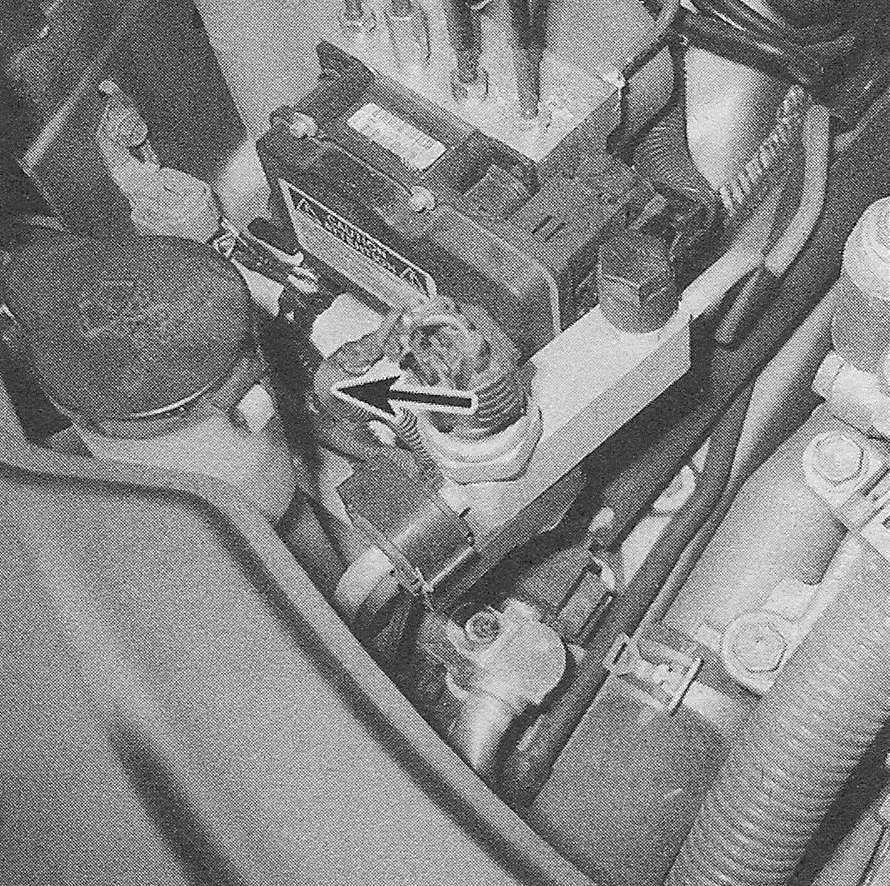
Brake and clutch fluid
15. The brake master cylinder is mounted on the front of the power booster unit in the engine compartment. The clutch cylinder, used with a manual transaxle, is located next to the master cylinder.
16. To check the fluid level of the brake master cylinder reservoir, simply look at the MAX and MIN marks on the reservoir (see illustration). To check the fluid level of the clutch master cylinder reservoir, note whether the fluid level is even with the maximum level line.
4.16 The brake fluid should be kept between the Max (A) and Min (B) marks on the reservoir
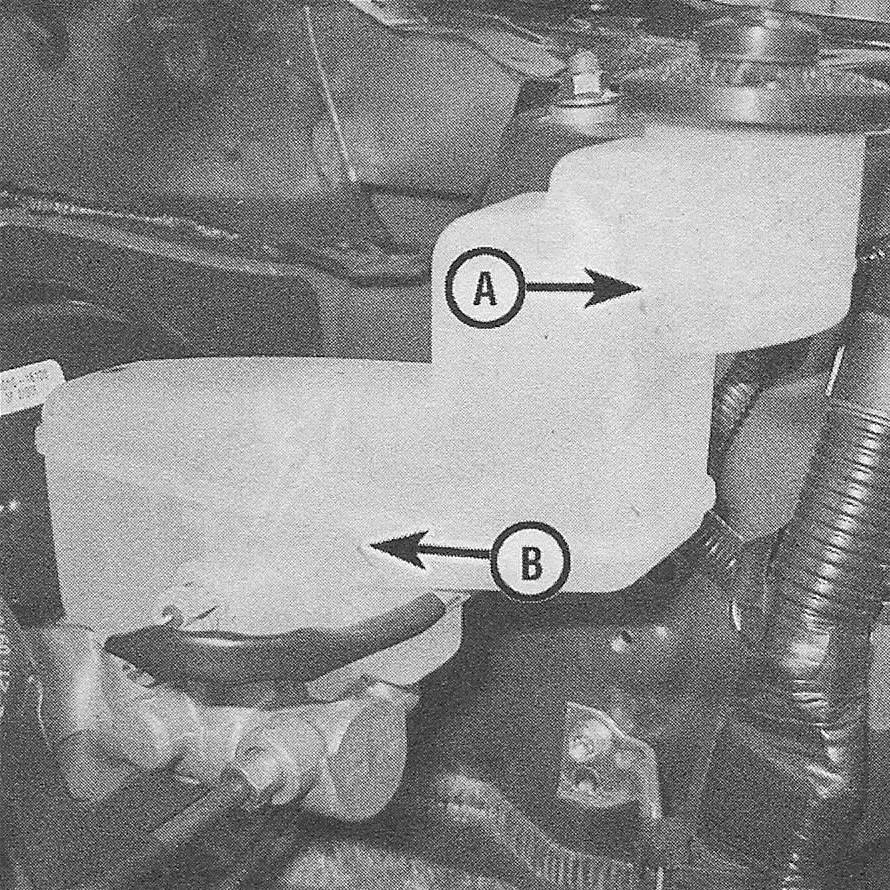
17. If the level is low for either reservoir, wipe the top of the reservoir cover with a clean rag to prevent contamination of the brake or clutch system before removing the cap.
18. Add only the specified brake fluid to the brake or clutch reservoir (refer to Recommended lubricants and fluids in this Chapter’s Specifications or to your owner’s manual). Mixing different types of brake fluid can damage the system. Warning: Use caution when filling either reservoir -brake fluid can harm your eyes and damage painted surfaces. Do not use brake fluid that has been opened for more than one year or has been left open. Brake fluid absorbs moisture from the air. Excess moisture can cause a dangerous loss of braking.
19. While the reservoir cap is removed, inspect the master cylinder reservoir for contamination. If deposits, dirt particles or water droplets are present, the system should be drained and refilled.
20. After filling the reservoir to the proper level, make sure the lid is properly seated to prevent fluid leakage and/or system pressure loss.
21. The brake fluid in the master cylinder will drop slightly as the brake pads at each wheel wear down during normal operation.
22. If the master cylinder requires repeated replenishing to keep it at the proper level, this is an indication of leakage in the brake system, which should be corrected immediately. Check all brake lines and connections, along with the calipers and booster (see Brake check for more information).
Power steering fluid level check
23. Unlike manual steering, the power steering system relies on fluid which may, over a period of time, require replenishing.
24. The fluid reservoir for the power steering pump is located on the right (passenger’s side) inner fender panel near the front of the engine.
25. For the check, the front wheels should be pointed straight ahead and the engine should be off.
26. The reservoir is translucent plastic and the fluid level can be checked visually (see illustration).
4.26 The power steering fluid reservoir is located on the right side of the engine compartment — the reservoir is translucent so the fluid level can be checked either hot or cold without removing the cap
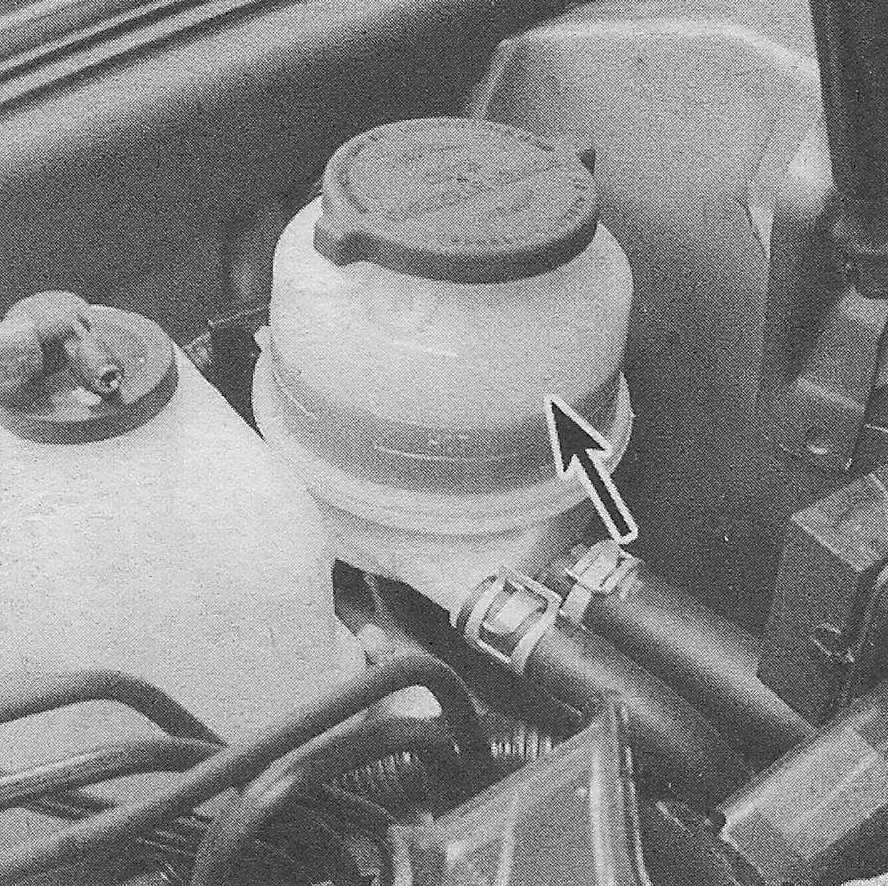
27. If additional fluid is required, pour the specified type directly into the reservoir, using a funnel to prevent spills.
28. If the reservoir requires frequent fluid additions, all power steering hoses, hose connections, the power steering pump and the rack and pinion assembly should be carefully checked for leaks.